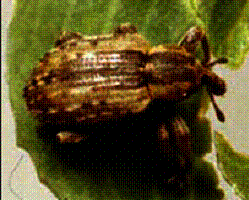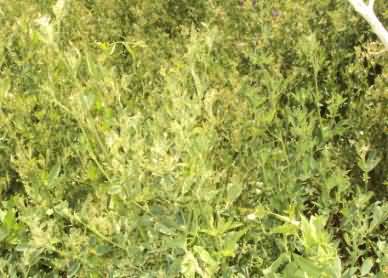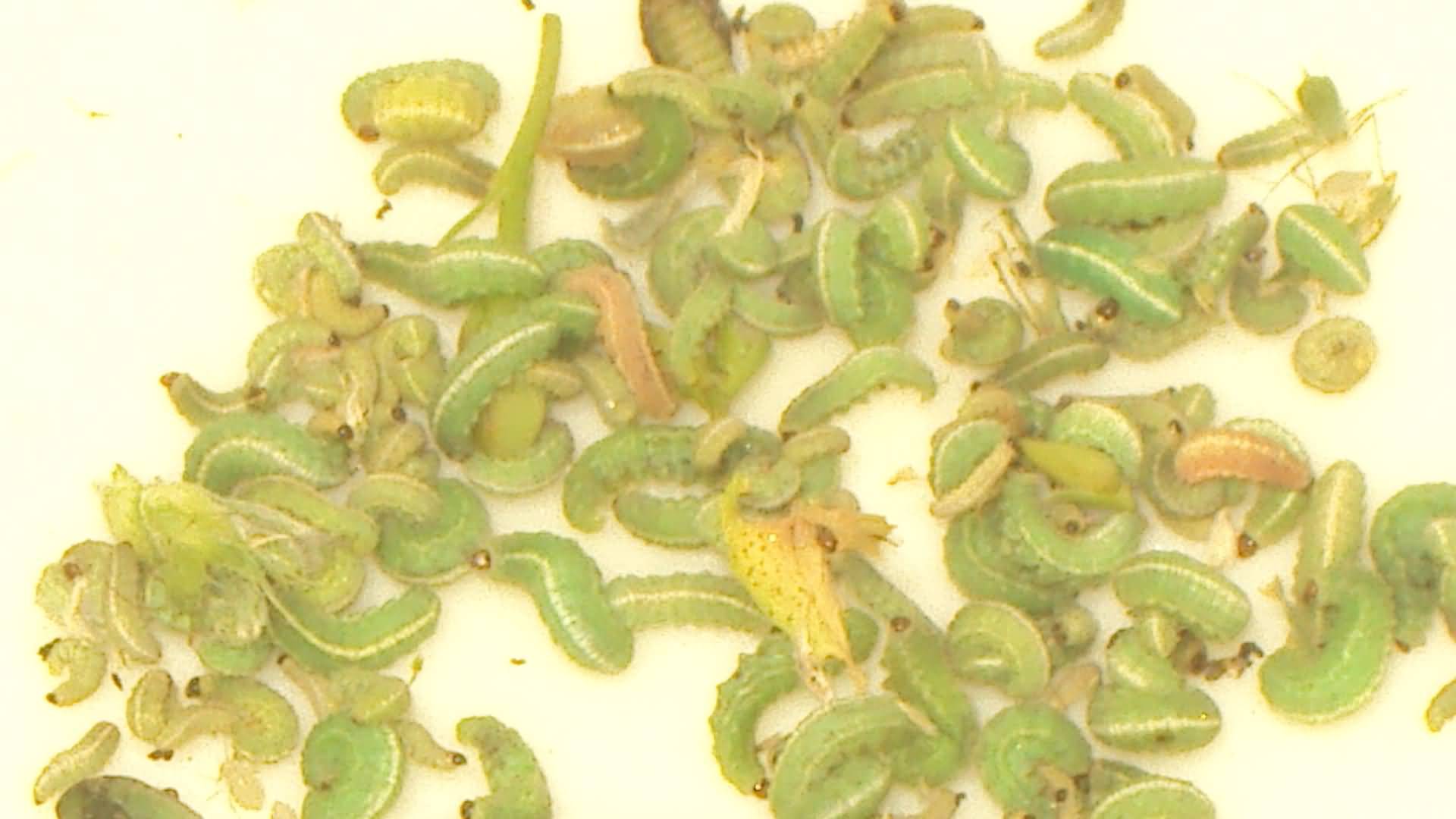अल्फाल्फा वीविल (Hypera postica Gyllenhal) के फैलने के लिए जिम्मेदार कारक का विश्लेषण

Forage production occupies a top priority by a farmer in cold arid region because long severe winter of 7-8 months is devoid of any vegetation greenery.
Alfalfa (Medicago sativa L.) also called as the "Queen of fodder or Green Gold" is the most important fodder crop grown in Ladakh region owing to its well adaptability in the region. It is locally named as 'Buksukh".
The crop being highly suited to the farming community, the cropping area has picked up and covered almost the entire area under fodder crops. It is a very important leguminous fodder grown as a perennial crop in cold arid zone. Once sown it continues to show good re-growth for 6-8 years with least management and cares in the subsequent years. It is one of the wonder plants of cold deserts that nurture soil, animals and human beings.
The crop is well adapted to vagaries of cold arid climate and provides safety and security through ensured returns to the farmers. It is a persistent, productive as well as heat and drought resistant crop which provides better seasonal distribution than berseem.
Alfalfa is a traditional crop in cold arid region and so far no new variety has been identified or released. Only the one local land race known as 'Ole' or 'Yarkandi Ole' is cultivated. Presently three cultivars are morphologically easily distinguishable (Chaurasia and Singh, 1996) which are:
- Medicago falcata: - It is yellow flower species and highly productive species compared to other species. Plant height varies from 30-150 cm. It shows mild resistance to insect pests.
- Medicago sativa: - it is purple flower species and mostly preferred due to more leafiness. Plant height varies from 30-100 cm. It is relatively more susceptible to insect attack.
- Medicago media: - It is white, dull white, light yellow to light purple species. It is tall vigorous plant species. It is intermediate in adaptation and susceptibility to insect attack as compared to other species.
A great number of insect species feed on alfalfa and some are capable of inflicting serious damage to the crop. Alfalfa weevil (Hypera postca Gyllenhal) is the most important species consuming foliage. The principal damage to alfalfa crop is caused by the feeding of larvae on inter veinal tissues, sometimes leaving only the leaf veins. Alfalfa weevil is an early season pest of alfalfa that affects the first cutting and sometimes the early re-growth of the second cutting. However, losses from this insect vary from year to year, but in some seasons they can be large enough to justify the application of an insecticide. During a diagnostic field survey in 2009 in Kargil region viz. Minge, Hardass, Akchamal, Shilikchey, Sankoo, Gongma and Khurbathang it was observed that the alfalfa weevil caused a significant damage to the alfalfa fodder crop at all the locations particularly in Khurbathang zone which is the major alfalfa growing area in the Kargil region. The key to economical management of the alfalfa weevil is combining crop management practices, biological control and the use of insecticides when weevil numbers are high enough to ensure that yield benefits outweigh treatment costs. The possible responsible factors for outbreak are mentioned here as under:-

(a) Nature of damage of alfalfa weevil
A. Abiotic factors
An analysis of the problem in relation to region revealed that the atmospheric temperature played a crucial role in the faster multiplication of the pest.
The prevalence of rainfall, snowfall and subsequently the low temperature up to the end of May influenced the severity of alfalfa damage to a greater extent during this period. But the onset of optimum temperature above 15 degrees Celsius from first week of June during the bud or flower initiation stage resulted in faster multiplication of the pest which gave a sudden spurt in the population of the pest and caused significant losses to the farmers. Spring weather conditions influence the severity of alfalfa damage.
During the prolonged cold spring the alfalfa weevil larvae do not grow as fast as alfalfa. In this situation the plant matures before weevil larvae can severely damage it. During warmer spring conditions larval populations will increase faster than plant growth resulting in extensive damage (Metcalf and Lukemann, 1982).

Alfalfa weevil Larva
B. Biotic factors
1. Cultural practices
(a) Monoculture:
There has been monoculture of this fodder crop from very long ago due to the best adaptability of this crop in this region. Moreover, there is very little diversity in this fodder crop, almost the entire fodder crop is under two to three genotypes.
Availability of a suitable host is important for outbreak of any pest species. A mixed planting of alfalfa and other palatable grasses, which normally grow along with alfalfa has been found to reduce the alfalfa weevil infestation in many areas.
It is therefore recommended to maintain diversity of various naturally growing different types of grasses in alfalfa fields. According to Bowman (1992), a mixed planting of alfalfa and other grasses can reduce infestation of alfalfa weevil larvae and leaf hopper levels in some areas.
Presently Oat (Avena sativa), which provides both fresh and dried fodder and does not need any plant protection measure, offers a viable economic alternative means of fodder production in cold region. Besides it will increase the diversity of the fodder cropping system and can reduce infestation of insect pests.
(b) Lack of crop management:
Any crop management practice that helps to produce a dense, uniform stand will make the crop better able to tolerate insect feeding. Almost no attention is given towards crop management practices in terms of irrigation, manuring and fertilization and on weed control.
Common weeds seen in alfalfa are Artemisia sp; Melilotus sp; Convolvulus arvensis; Lepidium latifolium; Chenopodium album and Agropyron repens. Dodder (Cuscuta reflexa Roxb.) which is a parasitic weed on Lucerne is spreading fast from the last few years. It propagates vegetatively and through seeds. Control of its seed setting is important.
(c) Delay in Harvesting:
Lucerne is preferred for harvesting at the initial or half bloom stage considering the nutritive value of herbage, maximum dry matter accumulation and the critical LAI of the crop during the season.
The harvesting should be done after 50-55 days of sprouting (second half of June to first week of July) in case of double cut varieties. A 30% percent increase in total produce has been reported by Singh (1999) in two times cutting compared to single cutting at maturity.
It has been observed that the fodder crop is not harvested at optimum time due to its poor growth and development as a result it falls prey to the attack of insect pests. Immediate cutting can be an alternative to the insecticide application if an economic infestation develops during the season.
If cutting cannot be made within the week then insecticide application should probably be made. Cutting before the optimum growth stage can reduce the dry matter yields although hay quality may be increased.
2. Balance in nature:
The pest has shown prolific reproductive and feeding potential only during the last few years. Thus it is necessary to understand the interaction between the forces which determine the insect population (reproductive potential of an insect itself under optimum condition) and the forces of annihilation or environmental resistance which denote the resistance offered by biotic and abiotic forces in an environment to the detriment of species (Pradhan, 1983).
Nature is able to maintain a striking balance between the forces of reproduction and annihilation. The environment gives rise to a force of annihilation which results in huge destruction which is necessary to keep the population below economic threshold level. Thus, a residual population is always present in ecosystem including an agro-ecosystem. A congenial environment mainly temperature leads to unusual or uncontrolled population resulting in population explosion.
3. Extension of cultivated area:
This fodder crop is grown extensively in the region and every year the area went on increasing. This also leads to easy availability of host plants for development of insect.
Tactics for alfalfa weevil management
The tactics for alfalfa weevil management can be grouped into two general categories:
1. Cultural control:
It involves the use of regular or slightly altered crop management practices to adversely affect pest species. The optimum time for harvesting of alfalfa crop is 50-55 days after sprouting. The damage due to weevil larvae coincides with blooming stage of the alfalfa crop.
Timing of harvest is the most important manipulation to reduce weevil problems. Immediate cutting can be an alternative even to the insecticide application if an economic infestation develops during the bud or early bloom stage.
2. Chemical Control:
To determine the need for insecticide treatment; assess the severity of an infestation by calculating the percentage of damaged terminals or by counting the number of larvae per stem or by counting the number of larvae captured with a standard 15-inch diameter sweep net.
If 30 to 50 per cent of the terminals are damaged or if larval counts average 1.5 to 2 per stem or if larvae average 20 per 180 degree sweep then make an insecticide treatment with Chloropyriphos 20 EC @ 0.02% or Dimethoate 30 EC @ 0.03% or Malathion 50 EC @ 0.05% or Endosulphan 35 EC @ 0.03% or Quinalphos 25 EC @ 0.04% or cut the crop immediately. If weevil numbers are high and the crop is starting to bloom harvest rather than spray.
References
-
Bowman, G. 1992. Grass in Alfalfa baffles bugs. New Farm Magazine, May-June. 22-23, 28-29.
-
Chaurasia, O.P. and Singh, B.1996. Cold desert plants. Vol.1 Leh Valley FRI. DRDO, Leh pp.146
-
Metcalf, R. L. and Lukeman, W.H. 1982. Introduction to Insect Pest Management (2nd Edi) John Wiley and Sons, New York, pp 446, 449-50, 453.
-
Pradhan, S. 1983. Agricultural Entomology and Pest Control. Indian council of Agricultural Research, Pusa, New Delhi, pp 267.
-
Singh, Brahama 1999. Alfalfa production in Ladakh. Unpublished Personal communication, DFAS, DRDO, New Delhi.
Authors:
Bashir Ahmad Rather and Sushil Kumar*
Regional Agricultural Research Sub-Station, SKUAST-K, Kargil, Ladakh (J& K)
*Regional Agricultural Research Station, SKUAST-K, Leh, Ladakh (J& K)
Email:
